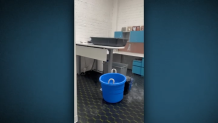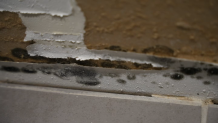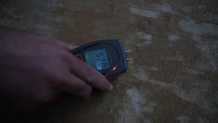Even if your home did not take on significant water damage after last week's nearyl unprecedented precipitation, you may want to keep a close eye now on walls and other parts of your home.
According to the Centers for Disease Control and Prevention (CDC), not everyone will have an adverse reaction to indoor mold. That said, some family members may be affected by it, so here’s what to know and what to do about it:
“As you can see, mold started growing even though we got here the second day after everything happened,” Omar Bailouni, co-owner of the water-damage restoration service Risk Free Serv, told NBC 7 about a Hillcrest business he was working at.

Get San Diego local news, weather forecasts, sports and lifestyle stories to your inbox. Sign up for NBC San Diego newsletters.
Huge amounts of rainwater came in like a waterfall through the skylights of the Hillcrest business and buckets they put out were not able to keep the water from flooding the offices.
“Within 24 to 48 hours after water damage, mold can start to grow,” Mohamad Bailouni, the other co-owner of Risk Free Serv, said.
Risk Free Serv was hired to mitigate the water damage, including looking for mold.
Local
“There is so much that is unseen, so by me just wiping the surface, what happens is that I get rid of maybe just 10% of it,” Mohamad said, adding that “the mold is on the paint, and if you peel the paint, right behind it, you still see the mold is on the paper of the drywall.”
If your home was damaged by water, how worried should you be about mold? Well, according to the CDC, some folks have a mold sensitivity that can lead to a stuffy nose, wheezing, red or itchy eyes or skin. People with allergies, asthma or other respiratory issues should take extra care.

Are all molds created equal?
No, they’re not. Some may be more hazardous than others, but the CDC recommends removing any mold growing in your home since the effect on people could vary greatly.
So how can I find mold without hiring someone?
Walk around every room and look for any discoloration on the walls or bubbles on the ceiling. Also, use your nose to see if you detect a musty smell.
Also, you can purchase moisture meters for about $25 to help find possible problem areas.
If it all checks out, then you probably don’t have any issues, but if you find moisture or mold, consider using a dehumidifier instead of a fan to dry it out.
“You do not want the air to hit the area that has mold in it," Omar said. "You just want the entire area to be dryer, and a little bit hotter, and that way you’ll slowly dry the drywall that has mold without spreading more all over the house."

Keep in mind that water damage is divided into three categories:
- Tap water
- Rainwater
- Flash-flood water
Tap water and rainwater are easier to manage, but flash-flood water can be filled with sewage and other toxins that require walls to be exposed right away.
“The carpet was soaked," Mohamad said. "The moment you stepped on it, water came out of the carpet. That's how drenched this place was."
The Bailounis said that many remediation companies offer free consultations to help better assess next steps. So if you do reach out to someone, check if they have an Institute of Inspection, Cleaning and Restoration Certification, or IICRC.
You should also check with your insurance company on deadlines to report water damage, which includes mold remediation. If you wait too long, the insurance company may not cover it.



